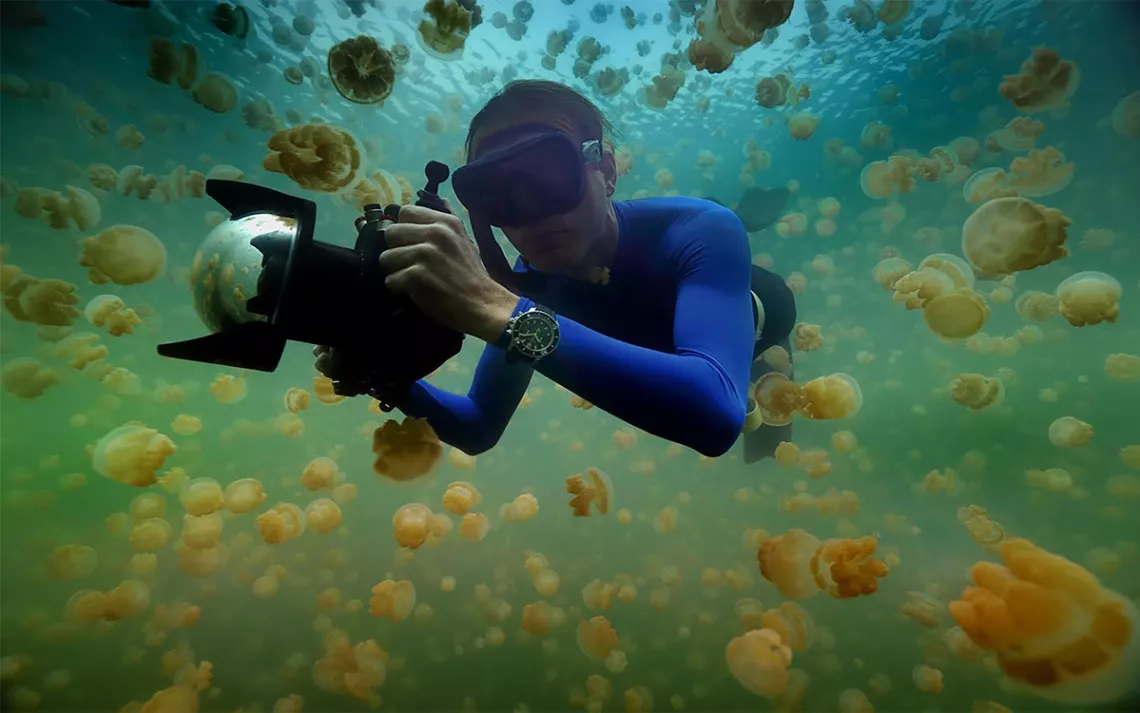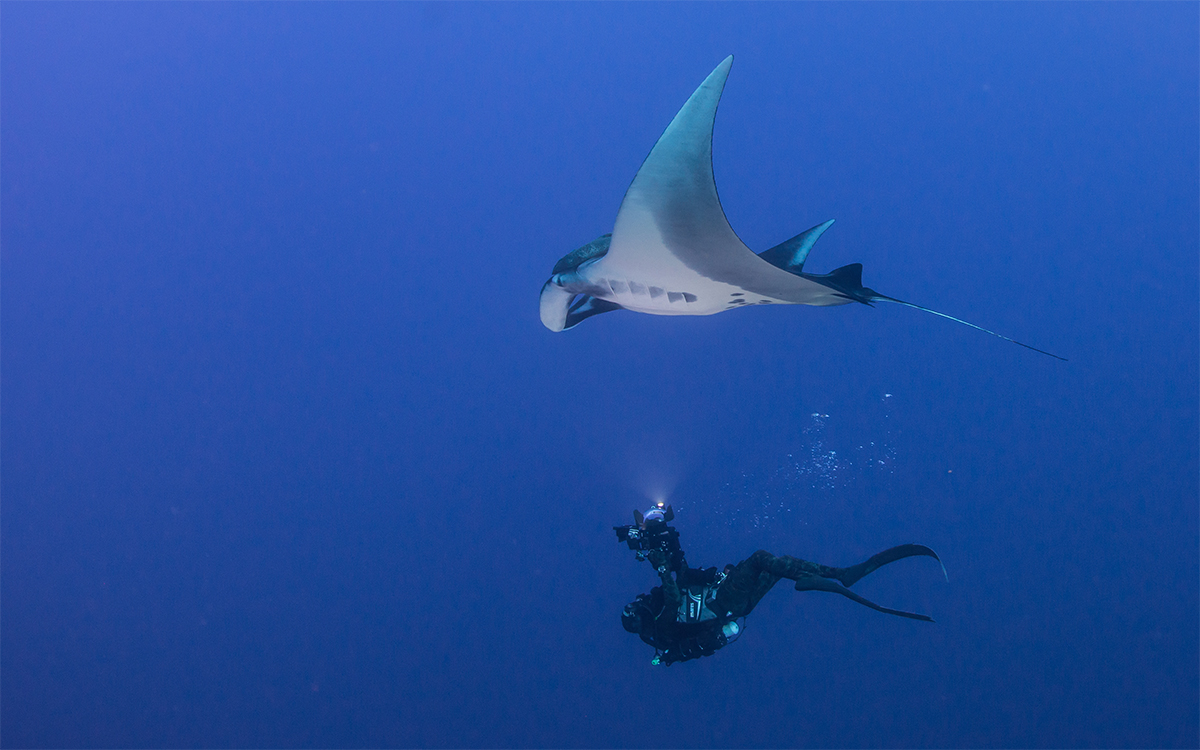Enric Sala Dives Into Wild Waters
The founder of Pristine Seas wants to do more than write the ocean’s obituary

National Geographic Explorer-in-Residence and Pristine Seas leader Dr. Enric Sala swims through Palau's famed Jellyfish Lake. Pristine Seas is an exploration, research, and media project with a mission to help protect the last wild places in the ocean. Learn more at PristineSeas.org. | Photo by Manu San Felix/National Geographic
Growing up on the Mediterranean coast of Spain, Enric Sala was fascinated by the ocean. A childhood playing in the sea led to a PhD in ecology from France's University of Aix-Marseille II and a professorship at Scripps Institution of Oceanography in San Diego. But one day, Sala was hit with a stark realization: “What I was doing was simply writing the obituary of the ocean," he says. "I was describing how ocean life was dying with more and more precision, but not offering a cure. I felt like the doctor who was telling the patient how she was going to die, but not offering a solution."
Then Sala read a National Geographic article about a man who trekked across central Africa and convinced the president of Gabon to create 13 national parks. He got excited—this was precisely what he wanted to do in the sea. After years of researching the ocean's problems, he decided to quit academia and dedicate his life to preserving the ocean. “I went to National Geographic and proposed a project combining exploration, research, and media to inspire governments to make marine reserves–national parks in the sea."
Sala's project, Pristine Seas, launched with National Geographic in 2008. "If you look in the dictionary, pristine means 'unspoiled, in the original condition,'" Sala says. "But what's original? In the same way that species evolve, ecosystems also evolve over long time periods. . . . For me, 'pristine' means before human exploitation."
That said, Sala acknowledges that even the most remote corners of the ocean have been impacted by humans. Today's technology and soaring human populations pressure marine resources as never before. "We are taking fish out of the ocean faster than they can reproduce globally," Sala says. "Ninety percent of the large animals are gone, like the tuna and sharks. Most fisheries will collapse by 2050." Add to that the impacts of climate change and 8 million tons of plastic entering the ocean annually and the future of the oceans is bleak.
"Large-scale human exploitation of the ocean began centuries ago," Sala says. "Because we don’t have science telling us how the ocean worked then, we go to the places that have received the least fishing, places mostly without people. These are the best proxies we have for what the ocean was like before we started messing it up globally." Sala and his team analyze databases of fishing, shipping, human population, and development to identify the areas least impacted.
Then the Pristine Seas team journeys to these remote locations to conduct intensive surveys by scuba diving, deploying deep drop-cams and pelagic cameras, and exploring by small submarine. Their scientific studies are often the first ever performed in these areas, resulting in discoveries of new species and fresh insights into how oceans work.

Underwater cinematographer Manu San Félix captures a unique perspective of a giant manta in the waters at Roca Partida, the smallest and most remote of Mexico's Revillagigedo Islands, on an expedition for the National Geographic Pristine Seas project. Pristine Seas is an exploration, research, and media project with a mission to help protect the last wild places in the ocean. | Photo by Enric Sala/National Geographic
One of Sala's most significant scientific findings has turned our understanding of marine ecosystems on its head. In terrestrial habitats, prey species far outnumber predators, but Sala’s team discovered that in intact marine ecosystems, the total weight—or biomass—of predators far exceeds that of prey.
When Sala published this discovery, his colleagues were incredulous. Sala explains, "In most scientific studies, scientists have gone to places long after the large animals were removed and we started degrading these marine ecosystems. So our view of the ocean is biased. We have very few good baselines of what the ocean is supposed to be." By studying these intact ecosystems "we are essentially traveling back in time," Sala says. "We are resetting the baseline of what a healthy ocean should look like."
In these remote waters, sharks rule, a fact that does not intimidate Sala. "I'm more afraid of the cab ride from home to the airport than diving with sharks," he laughs. “More people died in 2015 taking selfies with their smartphones than were killed by sharks worldwide!"
Sharks and other top predators are an important gauge for determining the overall health of a site. According to Sala, "If you jump in the water and immediately there are sharks, you can be sure that place is in good shape."
Gathering data is a crucial first step toward protecting a location, but the key is to engage government officials. Sala encourages presidents, prime ministers, and other leaders to join his team in the field. “When you can take a president diving, or in a submarine, you don't need to do much. It's inevitable that they will fall in love with these magical places."
After an expedition, Sala's team crunches the data and prepares arguments for protection. They present officials with photos, videos, and stories about their waters in order to cultivate "that deep emotional understanding that these places are very unique, and have an incredible value—that they are like nothing else." The team also makes the case that the economic value of the region is in protection, not exploitation. When specific areas are set aside as no-take marine reserves, the fishing in the surrounding waters improves dramatically.
This approach has been remarkably successful. Pristine Seas’ work has helped to protect more than 4.5 million square kilometers—that's almost half the size of the United States. This is only a small portion of Sala’s goal, which is to protect 10 percent of the world's oceans by the year 2020. "We're only at 3 percent today," Sala says. "Scientific studies recommend that we protect on average 30 percent of the ocean."
"We have a wonderful planet, and there is nowhere else to go," Sala says. "These pristine ecosystems are the key to preserve the health of the oceans and ensure our own survival."
To learn more about Pristine Seas, visit: http://www.nationalgeographic.org/projects/pristine-seas/
 The Magazine of The Sierra Club
The Magazine of The Sierra Club



